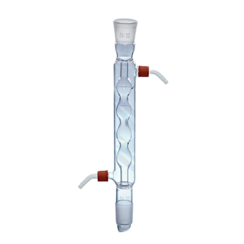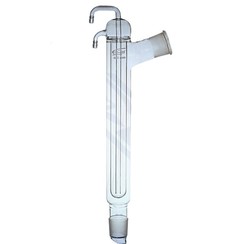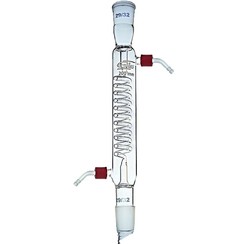You have no items in your shopping cart
Cooler / Condenser
Laboratory coolers / condensers are devices used in a chemical laboratory to condense gases and steam. Different types of coolers have been used depending on usage and factory temperature. The cooling effect is based on heat transfer processes on the cooling surfaces of the cooler. In addition to the coolant temperature, an important criterion for the cooling effect is the size of the cooling surface, the amount of heat the can has been transferred with the surface of the cooler. The cooling surface is actually a design feature of a cooler. Large cooling surfaces are made with special shapes such as cooling coils.
In terms of application, a distinction is made between product coolers and reflux coolers. Condensate formed in the first distillation as product value. In contrast, reflux condensers are designed to condense the vapors and return them to the still.
Product coolers, such as Liebig Coolers or Serpentine Coolers, have been used "descending" in the distillate at Separation, which is collected in a receiving flask, cooperating with the aid of a spin.
Reflux condensers are used in a vertical position. With this structure structure the condensate rises back into the flask, from receiving it through the supply of external heat from the released heat of reaction.
-Refrigerant
In most cases, running water is used as a coolant. With highly volatile condensates, such as acetaldehyde, the cooling water can be controlled with a cooling thermostat after a storage temperature has been cooled and pumped accordingly.
For high-boiling media with boiling points above 120°C, standing water is sufficient in many cases. At temperatures above 160°C, the ambient air is often sufficient as a cooling medium.
The cooling media was fed into the cooler according to the counter-current principle.
-Cooler-types
Allihn of spherical cooler
The tube of the Allihn-Koeler is wider than that of the Liebig-Koeler and is constricted at intervals. This results in a larger cooling surface and a stronger vortex of the steam. The type of cooler, which is also becoming cheap, is used exclusively as a reflux cooler. It is a document after the German glassblower Felix Richard Allihn.
Dimroth Cooler
The Dimroth-Cooler attaches from a cooling coil located in a tube. The type has a large cooling surface and is mainly used as a reflux cooler, but can also be used as a product cooler. It is owned by Otto Dimroth.
Liebig Cooler
The Liebig-Koeler (named after Justus von Liebig) mounts from a right-hand glass tube with a water jacket. It is often used as a product cooler in distillations, which can also place under high vacuum. Due to its simple construction, the Liebig cool box is cheap, robust and easy to clean. Due to the small cooling surface, the cooling effect is low and therefore less smart than the reflux condenser.
Intensive cooler
An intensive cooler is a combination of a Liebig cooler (outer cooling jacket) and a Dimroth cooler (inner cooling coil). The type of cooler has the largest cooling surface. It is therefore particularly suitable for working with low-boiling media such as diethyl ether.
Screw cooler according to Friedrichs
The Friedrichskühler, a cooler with a similar design to a cold finger, was created by Fritz Walter Paul Friedrichs, who published a concept for the cooler in 1912. It consists of a spiral glass tube which consists of a large cylindrical inner body. The cooling medium enters through the cold finger of the inner cylinder; Rising steam must be clicked on through the colder coil. The cooler also has a very large cooling surface, making it also suitable for the distillation of low-boiling compounds such as diethyl ether.
Air cooler
An air cooler attaches a small-walled tube in which the vapors are condensed by the ambient air as a cooling medium. Air coolers can be used as reflux coolers and product coolers for high boiling media (boiling point higher than 150°C). One for the air cooler is the sleeveless Vigreux column.
snake coer
In the spiral cooler, the riser wraps around in a spiral shape through the jacket provides the coolant. Due to its design, the cooler should always be served vertically. Because the condensate remains in the cooling coil for a long time, it is cooled to almost the coolant temperature. Coil coolers are therefore often arranged downstream of other cooler types with better condensing performance (Allihn cooler from Dimroth cooler) and not used as an independent reflux condenser.





